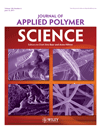Poly(ester)s containing germanium and silicon in the main chain, part 2: Static and dynamics behavior of monolayers at the air–water interface
Abstract
The static and dynamic behavior of the Langmuir monolayers of poly(ester)s containing germanium and silicon in the main chain (Scheme 1) is reported. True monolayers are found for all the poly(ester)s studied. The isotherms of surface pressure versus surface area for poly(ester)s exhibit a behavior of the expanded-type monolayers and that of condensed-type monolayers. It was observed that the addition of an hydrophilic polymer such as poly(monomethyl itaconate) to the water subphase produces significant changes in the isotherm properties. The interfacial rheology of the poly(ester)s monolayers has also been studied by using Oscillatory Barrier Experiments in a low-frequency range. It was found that the elasticity and the dilational viscosity increase from diluted monolayers until a surface concentration about 20 × 10−5 mg cm−2. The static and dynamic elasticities were found to be very similar for the poly(ester)s over the dilute range. It was possible to conclude that these poly(ester)s form extremely viscoelastic monolayers. © 2011 Wiley Periodicals, Inc. J Appl Polym Sci, 2011




